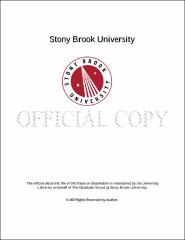| dc.identifier.uri | http://hdl.handle.net/11401/76217 | |
| dc.description.sponsorship | This work is sponsored by the Stony Brook University Graduate School in compliance with the requirements for completion of degree. | en_US |
| dc.format | Monograph | |
| dc.format.medium | Electronic Resource | en_US |
| dc.language.iso | en_US | |
| dc.publisher | The Graduate School, Stony Brook University: Stony Brook, NY. | |
| dc.type | Thesis | |
| dcterms.abstract | This research produces an objective, track-based climatology of Rossby wave packets (RWPs) and tests the sensitivity of the results to changes in the methods used in filtering the raw data and in tracking. NCEP/NCAR Reanalysis wind and geopotential height data at 300 hPa every 6 hours were spectrally filtered using a Hilbert transform technique under the assumption that RWPs propagate along a waveguide defined by the 14-day running average of the 300 hPa wind. After some spatial smoothing, the local maxima in RWP envelope amplitude (WPA) were tracked using two objective techniques: a point-based cost optimization routine and a hybrid of point identification and object-based tracking following rules similar to those used in the tracking of tropical convective clusters. The total energy flux term of the eddy kinetic energy equation was used as a cross-check for the purpose of hand-verifying RWP tracks in order to compare the performance of each tracking method. Track data and object-based descriptive statistics (including area, average intensity, intensity volume, intensity-weighted centroid position and velocity) were gathered to describe the inter-annual, annual, seasonal, and regime-based climatology of RWPs. When tracking methods are verified over two winter seasons and compared, the hybrid technique statistically outperforms point-based tracking, particularly when estimating track duration and propagation. When long lived RWPs are verified, there is strong evidence that some RWPs can last over 30 days and circumnavigate the Northern (Southern) Hemisphere up to two (three) times. RWPs are found to exhibit a much more pronounced seasonal cycle in the Northern Hemisphere, where they are nearly non-existent in the summer months (JJA), as compared to nearly continuous RWP activity downwind of South Africa during Austral Summer (DJF). Interannual variability in packet frequency and intensity in the Northern Hemisphere is found to be strongly connected with the large scale flow regime, with oscillatory patterns like ENSO and the AO playing significant roles. Enhanced WPA is also found to coherently propagate in composites of regime change events (e.g. a reversal of the AO). No significant long-term changes in RWP frequency or intensity are found; however, the North Pacific storm track appears to have shifted northward in the last thirty years. | |
| dcterms.available | 2017-09-20T16:49:42Z | |
| dcterms.contributor | Colle, Brian A | en_US |
| dcterms.contributor | Chang, Edmund | en_US |
| dcterms.contributor | Hameed, Sultan. | en_US |
| dcterms.creator | Souders, Matthew | |
| dcterms.dateAccepted | 2017-09-20T16:49:42Z | |
| dcterms.dateSubmitted | 2017-09-20T16:49:42Z | |
| dcterms.description | Department of Marine and Atmospheric Science. | en_US |
| dcterms.extent | 122 pg. | en_US |
| dcterms.format | Monograph | |
| dcterms.format | Application/PDF | en_US |
| dcterms.identifier | http://hdl.handle.net/11401/76217 | |
| dcterms.issued | 2013-12-01 | |
| dcterms.language | en_US | |
| dcterms.provenance | Made available in DSpace on 2017-09-20T16:49:42Z (GMT). No. of bitstreams: 1
Souders_grad.sunysb_0771M_11373.pdf: 6908906 bytes, checksum: 0edfa2275110332729b31a129f85aad8 (MD5)
Previous issue date: 1 | en |
| dcterms.publisher | The Graduate School, Stony Brook University: Stony Brook, NY. | |
| dcterms.subject | Atmospheric Waves, Climatology, Fluid Dynamics, Rossby waves, Synoptic Meteorology, Teleconnections | |
| dcterms.subject | Meteorology | |
| dcterms.title | An Automated, Track-based Climatology of Rossby Wave Packets | |
| dcterms.type | Thesis | |

